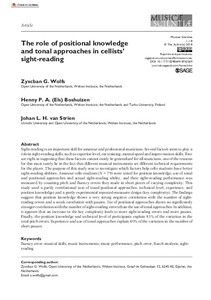The role of positional knowledge and tonal approaches in cellists’ sight-reading
Wolfs Zyxcban G.; Boshuizen Henny P. A. (Els); van Strien Johan L. H.
https://urn.fi/URN:NBN:fi-fe2021042719086
Tiivistelmä
Sight-reading is an important skill for amateur and professional musicians. Several factors seem to play a role in sight-reading skills, such as expertise level, ear training, mental speed and improvisation skills. If we are right in supposing that these factors cannot easily be generalized for all musicians, one of the reasons for this must surely lie in the fact that different musical instruments set different technical requirements for the player. The purpose of this study was to investigate which factors help cello students have better sight-reading abilities. Amateur cello students (N = 79) were tested for position knowledge, use of tonal and positional approaches and actual sight-reading ability, and their sight-reading performance was measured by counting pitch and fluency errors they made in short pieces of varying complexity. This study used a partly correlational (use of tonal/positional approaches, technical level, experience, and position knowledge) and a partly experimental repeated-measures design (key complexity). The findings suggest that position knowledge shows a very strong negative correlation with the number of sight-reading errors and a weak correlation with pauses. Use of positional approaches shows no significantly stronger correlation with the number of sight-reading errors than the use of tonal approaches. In addition, it appears that an increase in the key complexity leads to more sight-reading errors and more pauses. Finally, the position knowledge and technical level of participants explain 83% of the variation in the total pitch errors. Experience and use of tonal approaches explain 40% of the variation in the number of short pauses.
Kokoelmat
- Rinnakkaistallenteet [27094]
